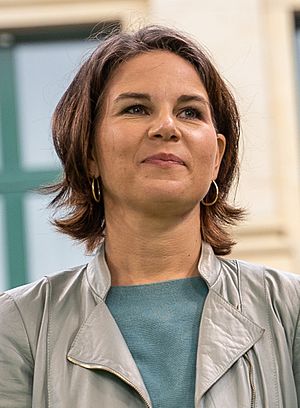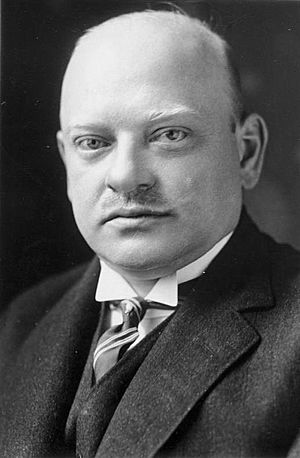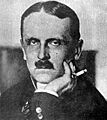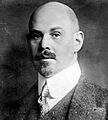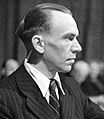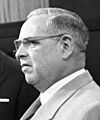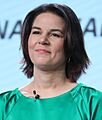Minister for Foreign Affairs (Germany) facts for kids
Quick facts for kids GermanyFederal Minister for Foreign Affairs |
|
|---|---|
 |
|
| Federal Foreign Office | |
| Formation | 21 March 1871 |
| First holder | Hermann von Thile |
| Website | auswärtiges-amt.de |
The Federal Minister for Foreign Affairs is a very important job in Germany. This person leads the Federal Foreign Office, which is like Germany's main office for dealing with other countries. They are also a member of the Cabinet of Germany, which is the group of top ministers who help the Chancellor run the country.
The person who holds this job right now is Annalena Baerbock. Since 1966, the Foreign Minister has often also been the Vice-Chancellor of Germany. The Vice-Chancellor is like a second-in-command to the Chancellor.
Contents
What is the Foreign Minister's Job?
The Foreign Minister is in charge of Germany's relationships with countries all over the world. They work to make sure Germany has good friends and partners. This includes talking with leaders from other nations. They also help solve global problems, like climate change or conflicts. Their main goal is to protect Germany's interests and promote peace.
A Look Back: History of the Office
The office that handles foreign affairs was first set up in 1870. Back then, it was called the Foreign Office. Its leader was known as the Secretary of State. This was in the time of the German Empire.
At first, the Secretary of State had a smaller role. The Chancellor, who was the main leader, usually handled foreign policy. For example, Otto von Bismarck, a very powerful Chancellor, was deeply involved in foreign affairs. The Secretary of State mainly helped by writing letters and documents.
Becoming a Full Minister
Things changed in 1919, after World War I. Germany became the Weimar Republic. The head of the Foreign Office was then made a full Foreign Minister. This meant they were directly responsible for their department. Ministers started to have more independence from the Chancellor.
One of the most famous Foreign Ministers was Gustav Stresemann. He held the job from 1923 until he died in 1929. His long time in office brought stability to Germany's foreign policy. He worked hard to improve relations between Germany and France. For his efforts, he won the Nobel Peace Prize in 1926.
Changes During and After World War II
When the Nazi regime came to power in 1933, the Foreign Office became less important. The Nazis made most of the big decisions themselves. After World War II, Germany was divided into two separate countries in 1949. These were West Germany and East Germany.
West Germany slowly regained its independence. In 1951, it re-established its own Foreign Office. For a few years, Chancellor Konrad Adenauer also served as the Foreign Minister. This was until West Germany had full control over its foreign policy in 1955.
The Foreign Minister Today
Since 1966, the Foreign Minister has often come from the smaller party in a government coalition. This means if two parties team up to form a government, the Foreign Minister usually belongs to the party with fewer seats. Because of this, the Foreign Minister often also becomes the Vice-Chancellor of Germany.
However, this has not always been the case recently. For example, the two most recent Foreign Ministers, Heiko Maas and Annalena Baerbock, did not also hold the Vice-Chancellor position. Other ministers held that role instead.
Images for kids
-
Bernhard von Bülow (1897–1900).
-
Wilhelm von Schoen (1907–1910).
-
Arthur Zimmermann (1916–1917).
-
Hermann Müller (1919–1920).
-
Walter Simons (1920–1921).
-
Joseph Wirth (1921–1922, 1922).
-
Walther Rathenau (1922).
-
Gustav Stresemann (1923–1929).
-
Heinrich Brüning (1931–1932).
-
Konstantin von Neurath (1932–1938).
-
Joachim von Ribbentrop (1938–1945).
-
Arthur Seyss-Inquart (1945).
-
Lutz Graf Schwerin von Krosigk (1945).
-
Lothar de Maizière (1990).
-
Konrad Adenauer (1951–1955).
-
Heinrich von Brentano (1955–1961).
-
Willy Brandt (1966–1969).
-
Walter Scheel (1969–1974).
-
Hans-Dietrich Genscher (1974–1982).
-
Helmut Schmidt (1982).
-
Hans-Dietrich Genscher (1982–1992).
-
Klaus Kinkel (1992–1998).
-
Joschka Fischer (1998–2005).
-
Frank-Walter Steinmeier (2005–2009).
-
Guido Westerwelle (2009–2013).
-
Frank-Walter Steinmeier (2013–2017).
-
Sigmar Gabriel (2017–2018).
-
Heiko Maas (2018–2021).
-
Annalena Baerbock (2021–present).


